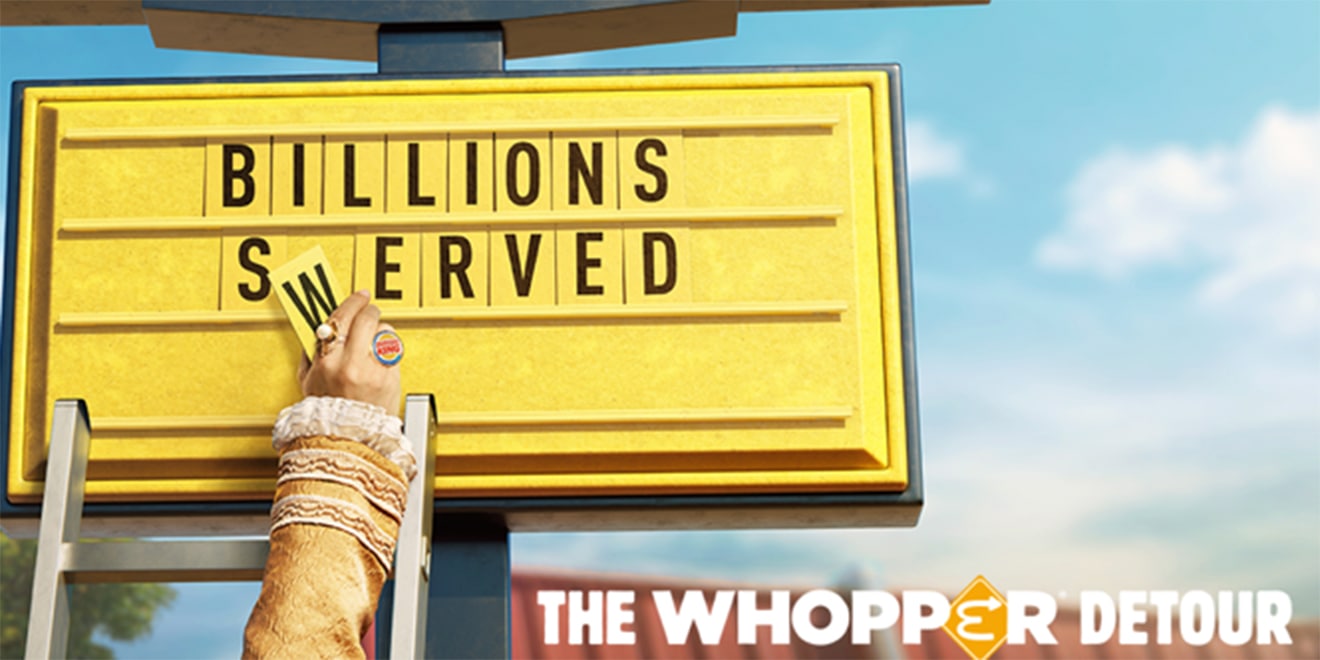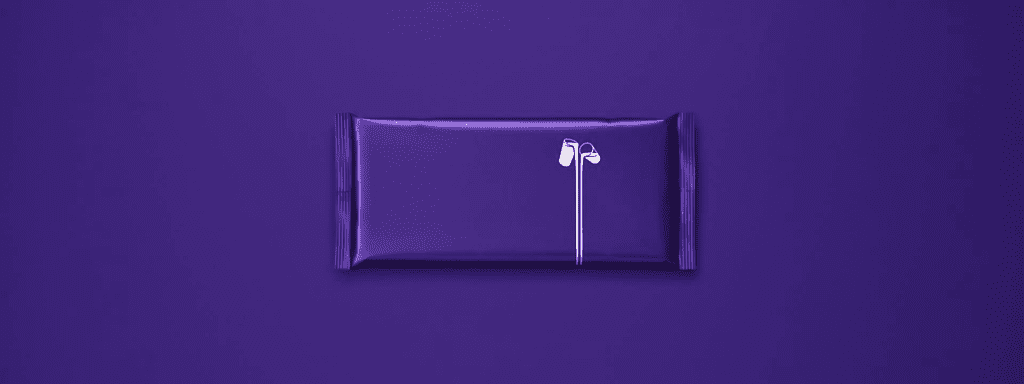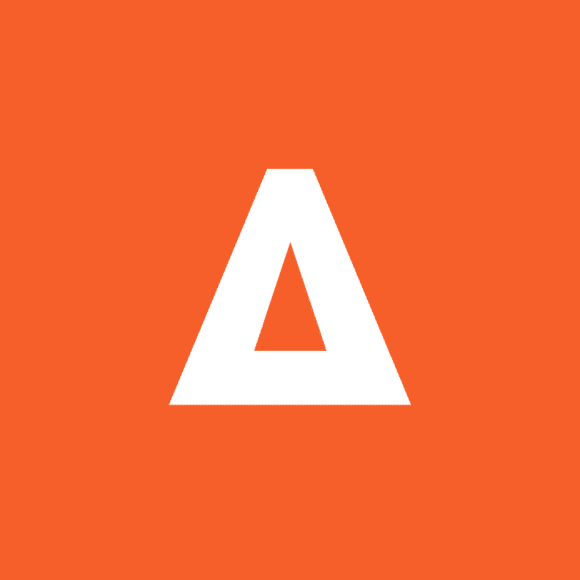The 10 most creative ad campaigns of 2019

Brands have got to get creative to stand out - we've rounded up the 10 most creative ad campaigns of 2019, so you can get inspired.
- Marmite: ‘breakfast means breakfast’
- Gillette: ‘we believe: the best men can be’
- The New York Times: ‘the truth is worth it: resolve’
- Microsoft: ‘We All Win’
- Sandy Hook Promise: ‘Back to school’
- - ‘Pressbyran National Cinnamon Bun Day’
- Burger King: ‘the whopper detour’
- Spotify: ‘listen like you used to’
- Cadbury: ‘donate your words’
- AeroMexico: ‘DNA discounts’
Brands are everywhere, and so are their ads.
On the TV. On billboards. On the Tube. On social media. Ads can end up becoming background noise as you’re going about your day-to-day life. All of that means it can be hard for brands to capture attention, stay relevant, and be remembered later on.
More now than ever, ads need to matter to consumers. They need to tap into something that sparks a reaction, they need to reach the right people at the right time, and they need to leave a lasting impression. It’s a tricky formula to perfect, but it’s not impossible. Here are 10 recent ads that were on the money, showcasing innovative ideas and a whole heap of creativity.
Marmite: ‘breakfast means breakfast’

Is there anything more divisive than Marmite? Definitely.
In this reactive print campaign released earlier this year, Marmite jumped on the Brexit bandwagon, cleverly fusing its reputation as an opinion-splitting product with Brexit’s infamy for causing a row.
Mixing Brexit into your ads might seem like a bit of a risky move, especially considering the disdain British people have for discussing it. But Marmite pulled it off, and the result was a whole lot of conversation around a brand that’s not necessarily always front-of-mind. It’s a great example of reactive marketing done right, and the resulting social media engagement proves it – when one of the responses to your creative ad campaign is: “Can we replace the PM with a jar of Marmite?”, you know you’ve probably tapped into that good old British humour (possibly as a result of much creative testing.)
The Beginner’s Guide to Campaign Planning
Working at a campaign level can transform the effectiveness of your marketing. Find out what it means to work at a campaign level and how you can get started with this free-to-download campaign planning guide.
Get Your Free CopyGillette: ‘we believe: the best men can be’
Playing off of its slogan, ‘The Best a Man Can Get’, Gillette released this purpose-driven campaign, ‘The Best Men Can Be’, at the beginning of 2019. Armed with beautiful cinematography and a message to get behind, the brand’s video ad presents powerful examples of toxic masculinity – from bullying in childhood all the way through to harassment as an adult.
The ad serves as a rallying cry to make a difference. As the #MeToo movement swept the globe, conversation around equality roared into the limelight, and Gillette grabbed hold of that momentum. The brand took aim at its audience, comprising mostly of men, and delivered a meaningful ad that garnered four million views in 48 hours.
As should probably be expected, this creative ad campaign was somewhat polarising – while millions praised the message and the polished delivery of it, many felt it was anti-men. Still, a strong reaction to this thought-provoking work was probably what Gillette set out to achieve in the first place. Controversial or not, this ad is evidence that Gillette took heed of its own advice – “it’s only by challenging ourselves to do more that we get closer to our best”.
The New York Times: ‘the truth is worth it: resolve’
Purpose-driven campaigns are all the rage, and the New York Times is no stranger to them. In its hard-hitting piece ‘The Truth is Worth it: Resolve’, it describes the arduous journey of an investigative journalist uncovering a well-hidden truth.
This video ad, by agency Droga5, is a fast-paced, raw-feeling glimpse into the reporting process, using cleverly edited footage of an investigative trip to Myanmar to uncover reports of genocide. It’s no light topic, but it’s handled expertly – everything from the shaky footage to the words quickly appearing and disappearing creates an urgency that emphasises the relentlessness of the reporting process.
At a time of rising anti-press rhetoric, the New York Times swung back – and boy, was it a hard-hitter. Spurred on by the motto “the truth doesn’t report itself”, this creative ad campaign went on to win a Grand Prix Lions award at Cannes Lions this year.
Microsoft: ‘We All Win’
In yet another win for purpose-driven advertising, Microsoft’s Super Bowl ad spot this year was an ode to accessibility in gaming. The video ad, created by agency McCann New York, tugged on the heartstrings of viewers as they presented several case studies of children with disabilities, who are now able to play video games thanks to Microsoft’s specially-designed hardware.
The message and the outstanding execution resonated with people, and the campaign became a viral sensation. The true weight behind it isn’t just in the quality of the ad, but the direct and measurable impact that accessible products have had on individual lives. In this case, Microsoft’s creative excellence is not only in its ad, but in the change the brand has helped to implement.
This meaningful change is recognised in the awards the campaign has won since, including the Cannes Lion Grand Prix award for Brand Experience and Activation, for significantly changing lives.
Sandy Hook Promise: ‘Back to school’
CONTENT WARNING: This video contains upsetting scenes.
It’s not an easy watch, but it’s a creative ad campaign that exists for all the right reasons – and it’s a perfect example of using creativity to its maximum effect.
Sandy Hook Promise, a non-profit organisation aimed at preventing gun violence in schools, released this harrowing video ad at the height of the back-to-school season. In the beginning, it masquerades as any old cheerful back-to-school ad, with kids presenting their new school supplies to the camera – but as the ad goes on, it transpires that the school is an active shooting scene, and the new school supplies are being used to prevent tragedy. Gym socks become tourniquets, a jacket tied around door handles becomes a barricade, and colouring pencils become emergency weapons.
The ad represents a harsh reality facing school-age children in America. It’s shocking, gripping, and in parts, horrifying. In capturing such a spectrum of emotion, Sandy Hook Promise and agency BBDO New York got people talking about the issue at hand. It’s the perfect example of creative assets with purpose at their core.
Pressbyran – ‘National Cinnamon Bun Day’

Bear with us here – this one’s a little outside the box.
National Cinnamon Bun Day is a big deal in Sweden. This year, one retailer went all out in an attempt to shift as many cinnamon buns as possible (with the bonus of a whole lot of brand awareness along the way).
Pressbyran, a Swedish convenience store chain, teamed up with agency Akestam Holst to create National Cinnamon Bun Day contact lenses, decorated to look like cinnamon buns – and they even featured a price tag. Employees in around 300 stores wore the strange-looking contacts on the day. This was combined with a multi-channel marketing campaign, including OOH ads, social media promotion, and an accompanying video ad.
The campaign sparked a lot of conversation, with mostly positive sentiment – though unorthodox, Pressbyran’s method was innovative, and their intentions good. It all made for an example of creativity we won’t forget in a hurry.
Burger King: ‘the whopper detour’
When data and a creative idea collide, you end up with the Whopper Detour.
In what has been heralded as a stroke of genius, Burger King and agency FCB New York came up with the idea to give out its signature Whoppers for just one cent – the only catch was, it had to be ordered from a McDonald’s location via Burger King’s app.
At its most basic, the Whopper Detour was simply a direct marketing campaign that featured a coupon for a cheap Whopper – but it was the use of data that transformed it into the creative end product. The novelty twist of ordering at a competitor’s restaurant paid off. 1.5 million people downloaded the Burger King app as a result of the campaign, and it has since won several awards, including a Grand Prix award in the Direct Lions.
Spotify: ‘listen like you used to’

In this multi-channel, creative ad campaign, Spotify capitalised on the powerful draw of nostalgia to remind people of listening trends gone by – and in doing so, it proved itself to be a brand with its finger on the proverbial pulse.
The ‘listen like you used to’ campaign, by Spotify and Who Wot Why, demonstrates the impact of knowing your consumers. Carefully-picked examples of past hits, and some clever wordplay, were curated to showcase the idea that while life may change, your listening habits don’t. And, exactly as intended, it resonated with a huge range of people. The well-constructed ads are an excellent example of creativity and consumer-led insight all packed into one.
Cadbury: ‘donate your words’

The blank Cadbury Dairy Milk bar isn’t just another example of minimalism in packaging design – it’s actually a powerful, purpose-driven ad campaign.
‘Donate your words’, by Cadbury and agency VCCP, creatively draws attention to the loneliness felt by the older generation. Removing all words from its famous packaging represents the silence experienced by the 1.4 million elderly people in the UK who have no one to talk to.
The empty packaging is accompanied by a moving video, which uses artful storytelling to showcase the experiences of older people who feel alone. The entire campaign is in support of Age UK, with 30p from each bar going to the charity. It checks all the boxes: creative? Check. Purpose-driven? Check. Well-executed? Check. It resonated with people in all the right ways, and inspired a conversation about not having a conversation.
AeroMexico: ‘DNA discounts’
Purpose meets small-mindedness meets reactive marketing in AeroMexico’s ‘DNA discounts’ campaign.
Created with the help of ad agency Ogilvy, this video ad is far more than a surface-level promotion of what Mexico has to offer tourists. At a time when tensions between Mexico and neighbouring American states are high, airline AeroMexico seized the opportunity to examine the divide, and make a proactive attempt to bridge the gap.
Though no politicians are mentioned outright, the campaign has political undertones, directed at President Trump’s promises of building a border wall – this is called out more directly in the line: “There are no borders within us”. The ad itself is an examination of American perceptions of Mexico, presented with a fun twist – the people interviewed in the ad (some of whom are decidedly anti-Mexico) are given a discount on flights to Mexico based on what percentage of their DNA is Mexican. The result is both uplifting and comedic – and it’s a shining example of creativity going the extra mile.
The best, most memorable campaigns are those that perfectly combine creativity and brand tracking data – but how is it done?
We packed a whole lot of insight, expert opinion, and handy hints into our marketing leader’s guide to campaign planning – grab your free copy to start squeezing the most out of each and every campaign. From creative testing to copy testing, ad testing packaging testing, we’ve got you covered!
Tell us what you think of this article by leaving a comment on LinkedIn.
Or share it on:

